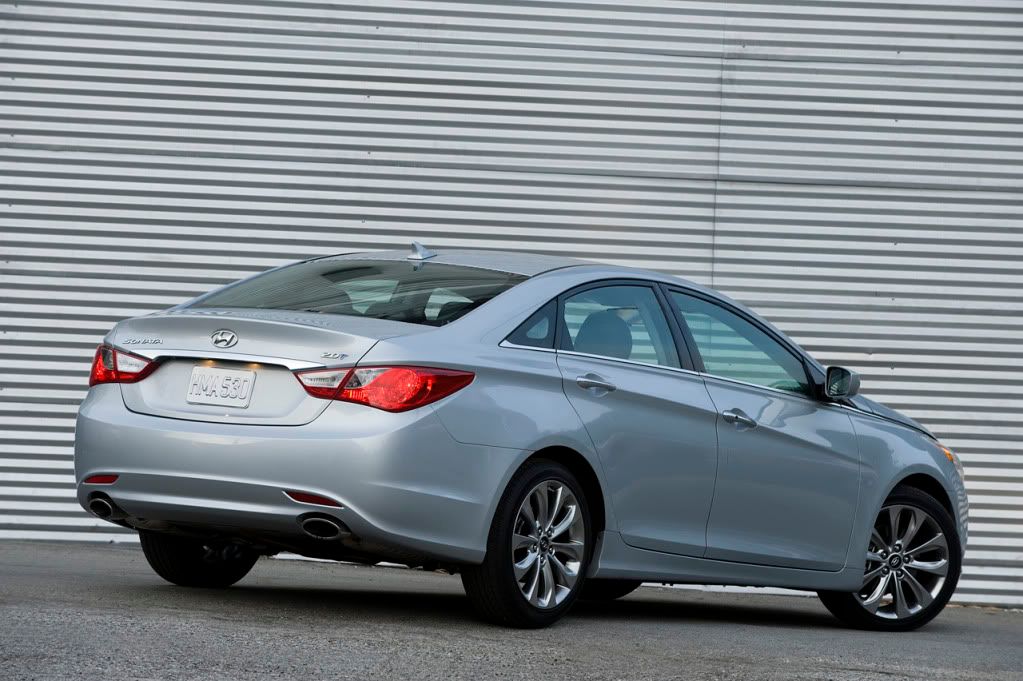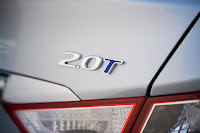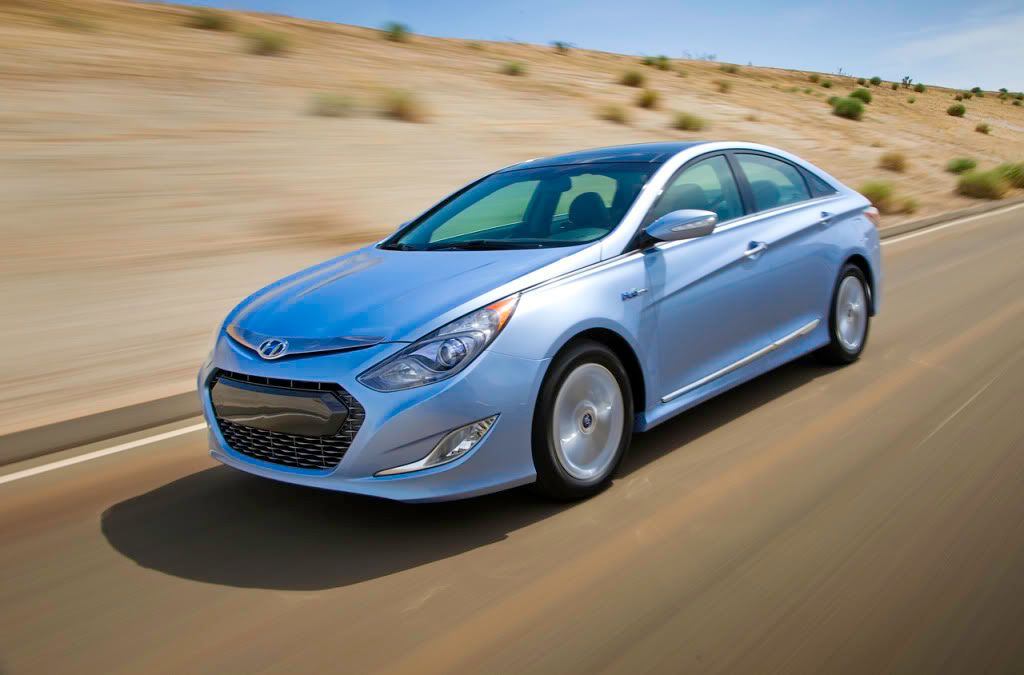Wednesday, March 31, 2010
New York 2010: Hyundai Unveils 274-HP Sonata Turbo (2.0T), Gets 34 MPG Hwy. Rating
0 comments Posted by ua bageur at 11:15 PM Hyundai today debuted the all-new 2011 Sonata 2.0T, powered by the brand's new 2.0L turbocharged version of its GDI 4-cylinder engine, at the 2010 New York Auto Show.
Hyundai today debuted the all-new 2011 Sonata 2.0T, powered by the brand's new 2.0L turbocharged version of its GDI 4-cylinder engine, at the 2010 New York Auto Show. The long-awaited Sonata 2.0T is fitted with a 2.0L Theta II turbocharged GDI (gasoline direct injection) engine that churns out 274 horsepower and 269 lb-ft of torque across a broad rpm range – 1,800 rpm – 4,500 rpm. The twin-scroll turbo system design minimizes turbocharger lag and gives the Sonata 2.0T 4-cylinder more power than many V6 engines, while running on regular fuel.
The long-awaited Sonata 2.0T is fitted with a 2.0L Theta II turbocharged GDI (gasoline direct injection) engine that churns out 274 horsepower and 269 lb-ft of torque across a broad rpm range – 1,800 rpm – 4,500 rpm. The twin-scroll turbo system design minimizes turbocharger lag and gives the Sonata 2.0T 4-cylinder more power than many V6 engines, while running on regular fuel.
The new 2.0L turbocharged gasoline direct-injection engine is part of Hyundai’s Blue Drive strategy. Mated to a 6-speed automatic transmission, Hyundai says that the Sonata 2.0T will deliver an estimated fuel-economy of 22/34 mpg (city/highway).
“The Sonata 2.0T is a great example of what our Blue Drive product strategy is doing for consumers,” said John Krafcik, Hyundai Motor America president and CEO. “Think about it – more horsepower than any of our V6 competitors, with better gas mileage than any competitive 4-cylinder model. We’re not fans of compromising at Hyundai, and the Sonata really demonstrates this aspect of our business approach.”
The 2.0T engine will be available on the SE and Limited trim level, with the 2.0T Limited getting additional upgrades such as panoramic roof and leather seating. Pricing details will be announced closer to its scheduled sales launch in late 2010.
[Source: Hyundai]
Continue reading to view more images.






Labels: Hyundai, New Car Releases, New York, Sonata, Turbo
New York 2010: All-New Hyundai Sonata Hybrid Gets Unique Look and Achieves 37/39 MPG
0 comments Posted by ua bageur at 9:01 PM The 2011 Hyundai Sonata Hybrid is the Korean company's first shot at the hybrid segment and it's not messing around. The Sonata Hybrid boasts the highest combined horsepower output of any hybrid sedan in its class and an expected best-in-class EPA highway rating of 39 mpg, not to mention the first use of lithium-polymer batteries in the automotive industry. That's pretty strong out of the gate.
The 2011 Hyundai Sonata Hybrid is the Korean company's first shot at the hybrid segment and it's not messing around. The Sonata Hybrid boasts the highest combined horsepower output of any hybrid sedan in its class and an expected best-in-class EPA highway rating of 39 mpg, not to mention the first use of lithium-polymer batteries in the automotive industry. That's pretty strong out of the gate. Here are the basics: The Sonata Hybrid combines Hyundai's 169-horsepower, 2.4-liter Theta II inline-4 with a 30-kilowatt electric motor. This particular Theta engine runs on the Atkinson cycle and uses continuously variable valve timing along with several friction-reducing technologies to boost efficiency by 10 percent compared to the standard Theta power plant. This hybrid powertrain's combined output of 209 hp tops all sedans in the class, while the Sonata Hybrid also happens to be one of the lightest midsize hybrid sedans at 3,457 pounds.
Here are the basics: The Sonata Hybrid combines Hyundai's 169-horsepower, 2.4-liter Theta II inline-4 with a 30-kilowatt electric motor. This particular Theta engine runs on the Atkinson cycle and uses continuously variable valve timing along with several friction-reducing technologies to boost efficiency by 10 percent compared to the standard Theta power plant. This hybrid powertrain's combined output of 209 hp tops all sedans in the class, while the Sonata Hybrid also happens to be one of the lightest midsize hybrid sedans at 3,457 pounds.
Like the Toyota Camry and Ford Fusion hybrids, the Sonata Hybrid can run on electric power alone, but Hyundai also claims its car can achieve 100 km/h (62 mph) in the electric mode. This is one of the reasons why the Sonata delivers such an impressive highway mileage number. The six-speed automatic transmission comes from Hyundai, but this application puts an electric motor in place of the torque converter, creating a hybrid powertrain that is more efficient and less costly than the CVTs used by its competitors, Hyundai says. More conventional elements of the Sonata Hybrid include a regenerative brake system, start/stop technology and an electric air-conditioning compressor.
Continue reading for the full article and more hi-res images.
You might not recognize the phrase "lithium polymer" in reference to the Sonata's batteries, as this is the first automotive application of the technology. Hyundai says the batteries are smaller, lighter and more durable than both nickel-metal hydride and lithium-ion batteries. For instance, the Sonata's battery pack weighs 28 pounds less than the one used in the Toyota Camry. It's also easier to package, which results in less intrusion into the trunk area.
In order to visually differentiate the Sonata Hybrid from the conventional Sonata, Hyundai has added a unique front fascia with a hexagonal grille, revised rocker panels, unique wheel designs and, of course, plenty of hybrid badging. Inside the cabin, the Sonata Hybrid also includes a technology display that gives drivers information on the available charge, power flow through the drive system and overall efficiency. It uses pretty colors to display it all, too.














 With a premiere at the Geneva Motor Show behind it, the 2011 Kia Sportage is headed for U.S. dealers later this year. The Sportage bows today at the 2010 New York Auto Show, and Kia's released this photo in advance of the North American debut.
With a premiere at the Geneva Motor Show behind it, the 2011 Kia Sportage is headed for U.S. dealers later this year. The Sportage bows today at the 2010 New York Auto Show, and Kia's released this photo in advance of the North American debut. Bearing some cues from the Kia Kue concept car, the Sportage takes an entirely different styling tack than the 2010 Hyundai Tucson, which shares its compact-crossover running gear. Bigger and more substantial by far than the previous Kia entry-level ute, the new Sportage wears some crisp, angular new sheetmetal over its larger interior spaces and upgraded cabin. The face looks familiar, if you've kept pace with the barrage of new Kias issued this year--Forte, Soul and Koup. The Sportage is maybe the most flamboyant, with dramatic side fender flares and a backswept rear end. Up front it's the latest evolution of the new Kia corporate face, but with lots of detail and some strong resemblance to the 2011 Kia Optima sedan--also on display in New York.
Bearing some cues from the Kia Kue concept car, the Sportage takes an entirely different styling tack than the 2010 Hyundai Tucson, which shares its compact-crossover running gear. Bigger and more substantial by far than the previous Kia entry-level ute, the new Sportage wears some crisp, angular new sheetmetal over its larger interior spaces and upgraded cabin. The face looks familiar, if you've kept pace with the barrage of new Kias issued this year--Forte, Soul and Koup. The Sportage is maybe the most flamboyant, with dramatic side fender flares and a backswept rear end. Up front it's the latest evolution of the new Kia corporate face, but with lots of detail and some strong resemblance to the 2011 Kia Optima sedan--also on display in New York.
The powertrain will be a 176-horsepower 2.4-liter four-cylinder that Kia says gets better gas mileage and makes more power than its former 2.7-liter V-6. A turbocharged four-cylinder engine is in the works, but power output is undisclosed. A six-speed manual is the standard on all Sportages; the front-driver gets options for a six-speed automatic with sport-shift controls (shared with the bigger Sorento crossover) and for all-wheel drive.The Sportage grows considerably in this edition--the length is up to nearly 175 inches, and the wheelbase checks in at 104 inches. The suspension is independent at all four corners, and Kia says ride quality is comfortable, while handling responsiveness is better in the new vehicle--as is noise and vibration control.
Continue reading for the full article
Dual front, side and curtain airbags will be standard, along with tire-pressure monitors, active headrests and a suite of electronic traction controls, from stability control to hill start assist to downhill brake control.
In standard specification, the Sportage LX will come with 16-inch wheels. The EX Sportage gets 18-inch wheels and more chrome trim on the door handles, grille, and on the body. It also adds roof rails and a rear spoiler.
The Sportage LX comes with power locks and mirrors; air conditioning; tilt steering; and cloth seats with a 60/40-split rear seat. The Sportage EX adds leather trim to the steering wheel and shift knob; dual-zone climate control; a colled glove box; a power driver seat; and an EcoMinder fuel-economy light.
Options on the LX will include 17-inch wheels; HD radio; navigation systems with real-time traffic; heated mirrors; power windows; heated side mirrors; a telescopic steering wheel; and the rear spoiler and roof rails of the more expensive editions. The EX's options include leather seats with heating and ventilation; push-button start; rear parking sensors; and a panoramic sunroof.
Both Sportage crossovers come with standard Sirius satellite radio and three months' service; USB audio inputs and Bluetooth connectivity; and UVO, a Microsoft-powered voice communication system like Ford's SYNC setup.
[Source: Kia]
Labels: Kia, New Car Releases, New York, Sportage
